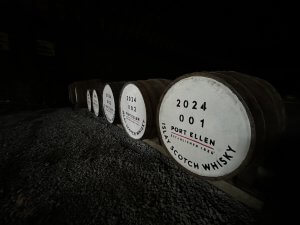Port Ellen: a phoenix rises

I Islay. Out there, the geese are flying north. Hundreds of them, black against the yellow and blue of the setting sky. Leaving. What happens in the silence after they’ve gone? The memory of the skeins caught in that bright yellow line. We wait for the return.
The memories of the distillery scroll in some sort of time-lapse: lights going out, roofs sagging, brickwork crumbling, the demolition team moving in leaving only the skeletal frames of the pagodas as a reminder.
I’ve got Benjamin Myers’ novel about St. Cuthbert, ‘Cuddy’, in my bag. Maybe that’s why my mind’s filled with religious imagery. The physical form decayed and lost, bottles as reliquaries holding the liquid equivalent of a saint’s bones. As the length of time from the silence stretches, so the legends grew and the humble servant becomes revered.
The drinking of Port Ellen made you complicit in its destruction, and with each bottle that was emptied, so the void was filled with memories and tales and the retelling of those tales. The less there was, the more precious it became. Its consumption was an act of mourning and in the way of these things, sentiment took over and critical faculties were paused. Do not speak ill of the dead.
This glass in front of me now with its fat fruits, soggy peat, treacle toffee and odd washing powder starchiness; its gaminess, salty sea lettuce, and bite of horseradish was the 14th annual exhumation, a 35yo distilled in 1978.
This next one, a 41 year old from 1980, smells of matchbox striker, mineral salts, peppered mackerel, and a high-end sushi restaurant. The wasabi comes on the palate, along with charred fish boxes.
Lovely drams. Fascinating drams. Challenging because any ghost distillery dares you to utter naught but superlatives. More ritual liquidations, but different this time because now the long silence is over. Now is the return.
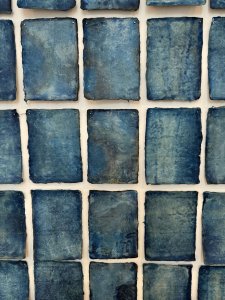
II The visit starts in an open space. A bright, white, modern art gallery with huge picture window looking out to the bay and the Carraig Fhada light. On one wall are 240 small pieces of washi paper which had been dipped in the Leorin Lochs (the distillery’s water source), then taken to Machir Bay where, coated with a emulsion of iron salts, cyanotypes were created, marking dawn to dusk on the longest day. A meditation on time and change.
Tea is brought. Small cups, Chinese style: a hojicha, roasted nutty, tobacco, hay; then Lapsang Souchong from Wuyi, elegant, pine smoke, dark fruits; and finally a Japanese black tea flavoured with plum blossom, fragrant and fruity, yet gripping. A way to ease people into the main building blocks of the distillery’s flavour. It might not be your standard ‘tour’, but it works.
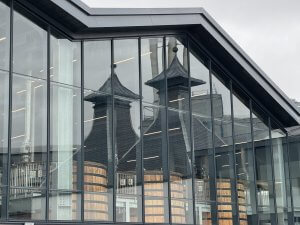
III The dunnage is cold, daylight illuminating a cask of 1979. That Port Ellen minerality, salt crystals on dried mango, drying smoke, hessian and rabbit glue. It sits at an angle from the first row of white-ended and stencilled casks containing the first of the new make. It’s a reminder. but also a farewell to the past. We leave the chill for the warmth of the stillhouse.
‘Nuts and bolts tour?’ asks manager Ali McDonald. Bring it on.
We duck outside to go and see the boiler (it runs off liquid biofuel) and one of many heat exchangers, recycling hot water from the condenser. Then it’s back inside to see Ali’s Marvellous Mill, undoubtedly the piece of kit he’s most excited about.
‘People think they’re boring,’ he says indignantly. ‘They’re anything but – especially this one.’ As he explains, it’s got six rollers, rather than the usual three allowing greater control over the grind. ‘Malt yield is estimated when it arrives at the distillery, but you’ll lose it in the mill. That’s looking at it from a business perspective, but what’s exiting me is how I’ll be able to fine-tune the grind to create flavour.
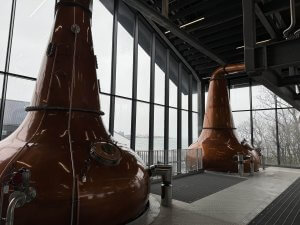
‘The past isn’t enough to live on,’ he continues. ‘What we do here at Port Ellen has to be about the future and here is the first pinch point in the distillery where I can influence flavour.’
Three different amounts of grist can be loaded into the mashtun – 7.5 tons when all four stills are running, six tons when only the Phoenix stills are on, and 5.5 tons for the experimental side.
The wort is clear for the ‘standard’ new make, but given the exploratory nature of the experimental side of the distillery he’ll be running different temperatures and clarity. The half dozen wooden washbacks hold the wash for between 98 and 130 hours in order to get the lactobacillus engaged and help give the fruity undertone. It was, Ali says, ‘what they did in the old days’.
The two ‘Phoenix’ stills are huge, bigger than I expected. Both wash and spirit have a high fill level, but are run slow to get reflux. On the spirit side, a long foreshot run (25-30 mins) leads into a middle cut that takes between four and five hours giving a new make with around 12ppm.
It’s sweet, with the smoke hanging there, the oils clinging, fruits yet to come.No-one has tried Port Ellen new make since 1983. Was this what it was like? That’s the wrong question. This is not the old Port Ellen reopened, it is a new distillery.
What’s the point in replicating what went before? Take those key elements and make something identifiably Port Ellen, but better. You cannot go back, nor can you wallow in sentiment of the good old days. You make and learn, build and improve. It will be Port Ellen. It will have fruit and oil and smoke and and minerality, but it will configure them all in its own way. And that is right.
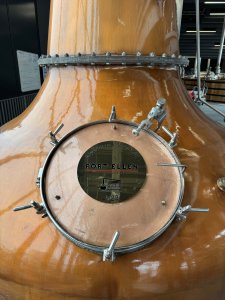
IV On the opposite side of the stillhouse are two smaller stills, one fifth the size, flanged so, in theory, different angles of lyne arms and neck lengths can be fitted. For some of the time the two ‘experimental’ stills will help boost the regular new make, but can also run independently. This is where they can play. ‘Anything goes,’ says Ali.
One of the (many) options is a deeper dive into ‘smoke’ pulling its components apart, finding new expressions, by analysing the entire process from Ali’s Marvellous Mill, to distillation.
Rather than relying on the overly simplistic measurement of phenolic parts per million, this will be a forensic dive using the distillery’s on-site laboratory into the relationships and balances between ‘smoky’ components and how changes in process can create different aspects.
It’s similar to what Torabhaig has done in its breakdown of the ratios between phenols, guaicol and cresol to create specific flavours. Smoke isn’t just smoke, peatiness isn’t just peatiness.
Breaking the new make apart will be made possible by the number of tanks linked to the experimental side’s spirit safe. The Phoenix side has separate low wines and feints receivers, a charger and an ISR for the new make. The experimental side however has four tanks which can work either as foreshots and feints receivers/chargers, as well as two ISRs.
There are also three SRWV vessels, one for Phoenix for the spirit which will be tankered off, and two for the experimental side whose new make will be filled on site.
The higher number of tanks on the experimental side will allow intermediate cuts to be made during the spirit run in order to capture specific flavour compounds. While the initial cut from foreshots to heart is made manually, a sequence can be run to determine which vessels the subsequent spirit can run to by an air activated control valve. It’s not just about opening, but opening up. With fast-growing Portintruan building a dedicated pilot distillery (containing two pots, two pot/retort and a column still), Islay’s south coast is set to become the island’s heart of experimentation.
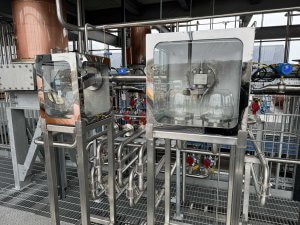
V The question for the marketeers is how to deal with the ghost’s seductive whispers.‘Keep me the same,’ it says. ‘Just rebuild… look at where we are’, but the new Port Ellen can’t just be the same. It has to be better, because all whisky, surely, has to be better each day.
Consistency and adherence to one set of rules means stasis. Diageo realises that if Port Ellen doesn’t move, what was a ghost distillery will only be a zombie one. You can never go back. You can learn from the past, but you cannot return – and to be honest do you want to? Go back to those last days when everyone knew the writing was on the wall?
The bigger question is how it will be sold. I haven’t a clue what the price of the new Port Ellen single malt will be, but can you simply price it as luxury, or does it have to earn that right?
Let’s face it, the old Port Ellen only reached cult status by accident, not design. It achieved its apotheosis thanks to the rise in single malt, the emergence of Brand Islay, the attraction of the ghost distilleries, and the fact that after decades in refill casks it could finally reveal its full character. Let’s play a game. What if Port Ellen hadn’t closed? Would it be revered today above Lagavulin, Ardbeg, Laphroaig? Answers on a postcard please.
When its first new bottlings appear they will have to compete on quality terms, not just with its Kildalton coast rivals, but with another eight (ten?) from the island, plus all the other smoky single malts from around the world. When its 12 year old appears, will it be the same price as Caol Ila 12yo, or more, and if more… why?
It won’t be rare, or finite in supply. It will be a new distillery making 1.6million litres a year. Is it right for the new Port Ellen to coast on the reputation of what was made 40 years ago, or earn a new one in your own right? It, like the reborn Brora and Rosebank, has to earn its stripes.
The distillery is open. It is beautiful, the team’s enthusiasm is palpable, the thinking is great, the opportunities huge, but now the hard work starts. As Ali says, the past isn’t enough to live on.
